Heat Exhaustion vs Heat Stroke
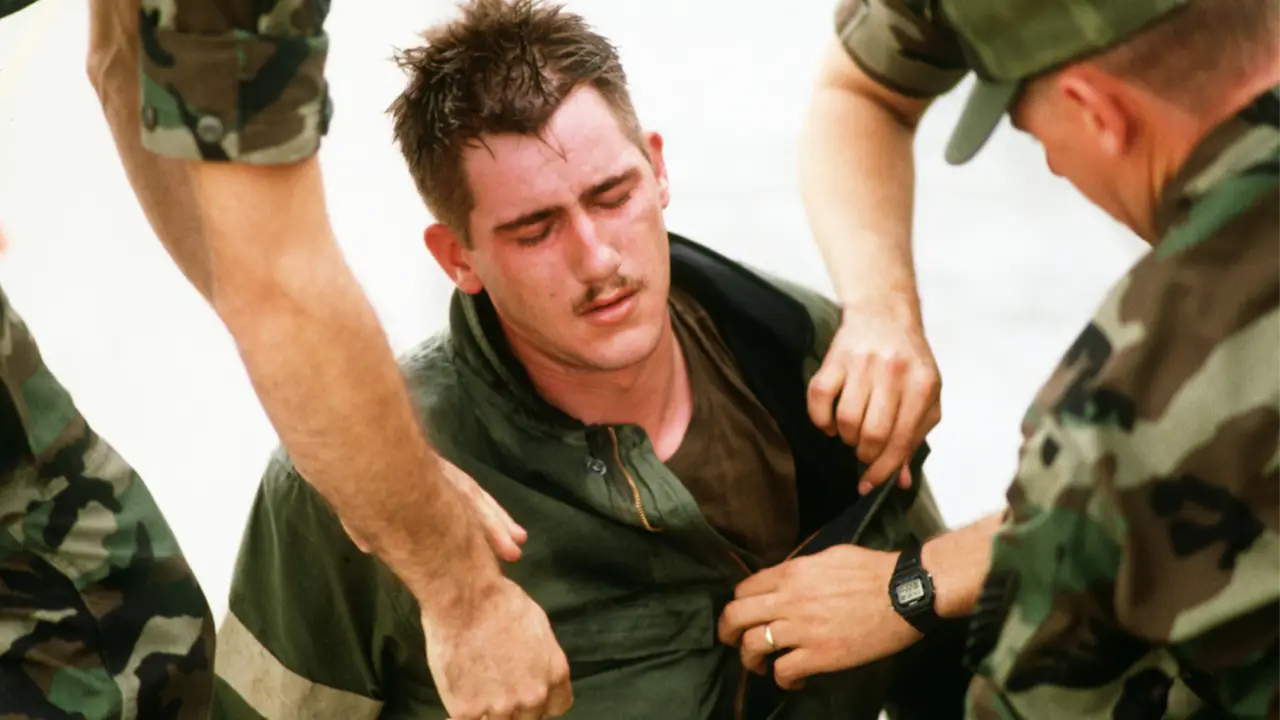

First aid treatment for heat exhaustion and first aid treatment for heat stroke are not only important interventions but can prove to be life-saving ones.
These are the two most serious forms of heat-induced illness.
With causes that share commonalities and many similar signs and symptoms, it’s important to understand the differences between heat stroke and heat exhaustion.
The single most important difference between heat exhaustion and heat stroke is that heat stroke is a life-threatening medical emergency. Both heat conditions are caused by a dramatic rise in body temperature.
Heat exhaustion is a likely event when a person’s body temperature rises above 37° C — the body’s normal operating temperature is 36°–37° C.
When body temperature goes over 40° C, the deadly threat of heat stroke enters the picture.
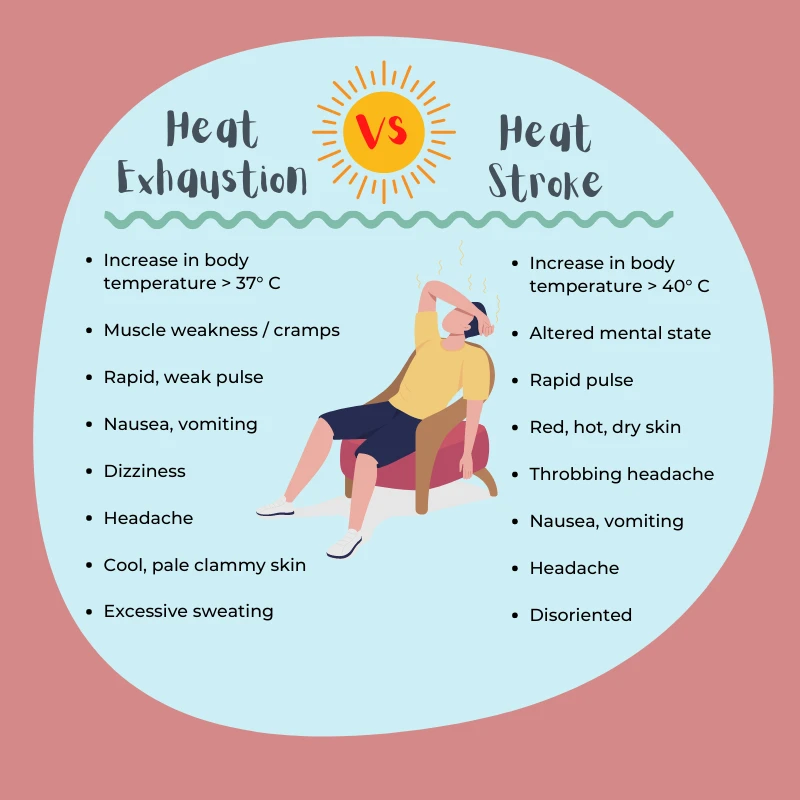
Heat exhaustion is a heat-related illness that is associated with body temperatures of 37°–40° C and often accompanied by dehydration.
Dehydration causes a deficit of water and essential salts (electrolytes) in the body, reducing its ability to sweat. To deal with excess internal heat, the body would normally pump blood to the surface of the skin and release sweat.
A person who is unable to cool down by sweating is vulnerable to heat exhaustion.
This loss of body fluids and salts caused by decreased blood pressure and blood volume after prolonged exposure to high heat leads to fatigue — one of the major signs of heat exhaustion.
Heat cramps may also present.
Other signs to look for in heat exhaustion, include heavy sweating and dilated pupils.
Symptoms of heat exhaustion also include:
Symptoms of heat exhaustion in children are similar to those in adults. Children may:
It is important to treat a child with heat exhaustion immediately.
There are two types of heat exhaustion:
Water depletion – signs include excessive thirst, weakness, headache, loss of consciousness.
Salt depletion – signs include nausea and vomiting, muscle cramps, dizziness.
Heat exhaustion, although not as serious as heat stroke, is serious nonetheless. If proper intervention is not forthcoming, heat exhaustion can progress to heat stroke.
With prompt and appropriate treatment of heat exhaustion, symptoms of heat exhaustion will begin to improve within 30 minutes. In most people, full recovery is expected within 24-48 hours.
Medical attention should be sought if symptoms show no sign of improvement after 30–60 minutes.
Professional medical treatment for heat exhaustion would likely involve one or two litres of intravenous (IV) fluids and electrolytes. If symptoms are not resolved by fluids and rest, a doctor might then order blood work and other tests to rule out other potential causes.
For further details and tips for prevention of heat exhaustion, please see our in-depth article Heat Exhaustion First Aid.
First aid treatment for heat stroke is critical. This is the most serious of heat-induced illnesses.
Immediate medical intervention is necessary to avoid brain damage and damage to the heart, kidneys, muscles, as well as possible coma and death.
Heat stroke, also known as sun stroke, is associated with body temperatures over 40° C.
It is also known as ‘core temperature emergency’ where the body overheats, within 10 to 15 minutes, reaching temperatures that are dangerously high.
At core temperatures above 40º C, the body’s temperature regulation centre in the brain ceases to function properly.
First aid aims to quickly cool down core body temperature while waiting for emergency services to arrive.
The signs of heat stroke include dry skin (lack of sweat), rapid, shallow breathing, pupils concentrated.
Symptoms of heat stroke also include:
Following quick and effective heat stroke first aid, it would usually take a day or two in the hospital to recover. In the case of organ damage caused by swelling, recovery will be considerably longer.
Organ damage ranges from fair to poor. The prognosis changes dramatically for the worse as complications increase. If permanent damage has been done to the brain, lungs, liver, or kidneys, the effects will be long-term.
For further details and tips for prevention of heat exhaustion, please see our in-depth article Heat Stroke First Aid.
The body’s natural defence mechanism against excessive heat is sweating.
Sweating dissipates heat through the skin and through lung moisture evaporation. For this reason, loose-fitting, light-coloured clothing is preferable in hot weather.
In hot weather, avoid strenuous activity, such as training, long-distance running, and playing sports. If you notice muscle cramps or feel weak, cease activity immediately and cool down.
Avoid hot areas in direct sun and avoid sitting in a parked car in hot weather (a common cause of heat stroke in children).
During sustained hot weather, air conditioning is more effective than fans to cool down and lower humidity.
Stay well-hydrated. If you find yourself emptying your bladder only infrequently, or your urine is concentrated, you need to increase your fluid intake. Drink oral rehydration ‘sports drinks’. Avoid alcohol.
The risk of heat stroke is increased by medications, such as diuretics, stimulants, and sedatives. Check with your pharmacist or doctor.
Give yourself time to acclimatise if you plan to go to a hotter climate. This means limiting your outdoor activities for a few days, or more if you have risk factors for heat-related illness.
Disclaimer: This article is for informational purposes only. It does not constitute, replace, or qualify as any form of first aid training.
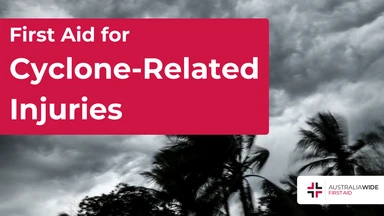
March 3, 2025
Injuries during cyclones often result from flying debris, collapsing structures, and flooding. Knowing basic first aid can help prevent further harm while waiting for emergency services.
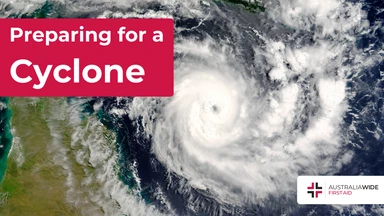
March 3, 2025
If a cyclone makes landfall, meaning that it crosses from the sea onto land while still being strong enough to be classified as a cyclone, the damage it can cause can be disastrous. Preparation is key to minimising the risks associated with cyclones. The damaging weather can last for days, exacerbating risks as hazards intensify.
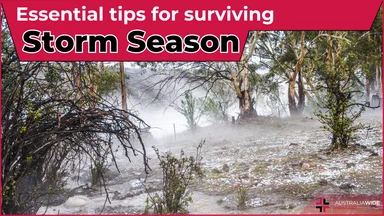
November 1, 2024
Severe storms are a common and dangerous occurrence in Australia, particularly in regions like Queensland. These storms can bring large hail, damaging winds, heavy rain, and occasionally tornadoes, all of which can put both people and property at risk. Preparing for and responding to severe storms effectively is key to ensuring safety.